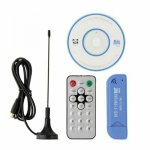lwvmobile
DSD-FME
Didn't want to make a separate thread for each of these, since this is more of a discussion than it is a set of precise questions, but what would you consider to be acceptable PPM error on a cheap Blue/Black RTL-SDR Dongle? Currently, I have 4 of them, three from one vendor, and one from another vendor. On the outside, they look the same, but come with a different package set. For context, this is the 'package' I ordered and received over the weekend from eBay.

My other 3 dongles that look like this, albeit black, have a PPM error of around 2PPM. This blue one up above, is 50, FIFTY, PPM off from hitting the frequency you really want to land on. I was just wondering if this is something I should treat as acceptable, or not. Knowing that its 50 PPM, and when using that one specifically making sure to give it the correct values, it seems to operate fine, and I haven't noticed any sort of significant problems with it otherwise(yet). I was just wondering if anybody else has encountered this sort of thing on these cheap knock off of knock off dongles or not.
My second rambling, does anybody use a Raspberry Pi 3B+ or similar SBC with a battery for SDR activities? If so, what size battery pack do you use, and what kind of battery life do you typically see when using say, 2 SDR Dongles and decoding software like OP25 or similar? I was pondering making some sort of setup in my truck to use or at least test the waters a bit. I originally was considering just using my piddly dual core celeron ultrabook for this task, but to be honest, just running two rtl_fm instances and DSD maxes that thing out. Its still a viable option for some tasks, has a build in screen, keyboard, and battery that can run for a couple hours under load, but I seem to remember the quad core ARM on the 3B+ handling the same tasks much better, so thought perhaps that's the way to go if anybody has any experiences they want to share using a Pi and a battery pack with dongles and SDR software, I'd love to hear how it went for you and also what kind of run time you get on a full battery pack and what size pack you used.

My other 3 dongles that look like this, albeit black, have a PPM error of around 2PPM. This blue one up above, is 50, FIFTY, PPM off from hitting the frequency you really want to land on. I was just wondering if this is something I should treat as acceptable, or not. Knowing that its 50 PPM, and when using that one specifically making sure to give it the correct values, it seems to operate fine, and I haven't noticed any sort of significant problems with it otherwise(yet). I was just wondering if anybody else has encountered this sort of thing on these cheap knock off of knock off dongles or not.
My second rambling, does anybody use a Raspberry Pi 3B+ or similar SBC with a battery for SDR activities? If so, what size battery pack do you use, and what kind of battery life do you typically see when using say, 2 SDR Dongles and decoding software like OP25 or similar? I was pondering making some sort of setup in my truck to use or at least test the waters a bit. I originally was considering just using my piddly dual core celeron ultrabook for this task, but to be honest, just running two rtl_fm instances and DSD maxes that thing out. Its still a viable option for some tasks, has a build in screen, keyboard, and battery that can run for a couple hours under load, but I seem to remember the quad core ARM on the 3B+ handling the same tasks much better, so thought perhaps that's the way to go if anybody has any experiences they want to share using a Pi and a battery pack with dongles and SDR software, I'd love to hear how it went for you and also what kind of run time you get on a full battery pack and what size pack you used.


